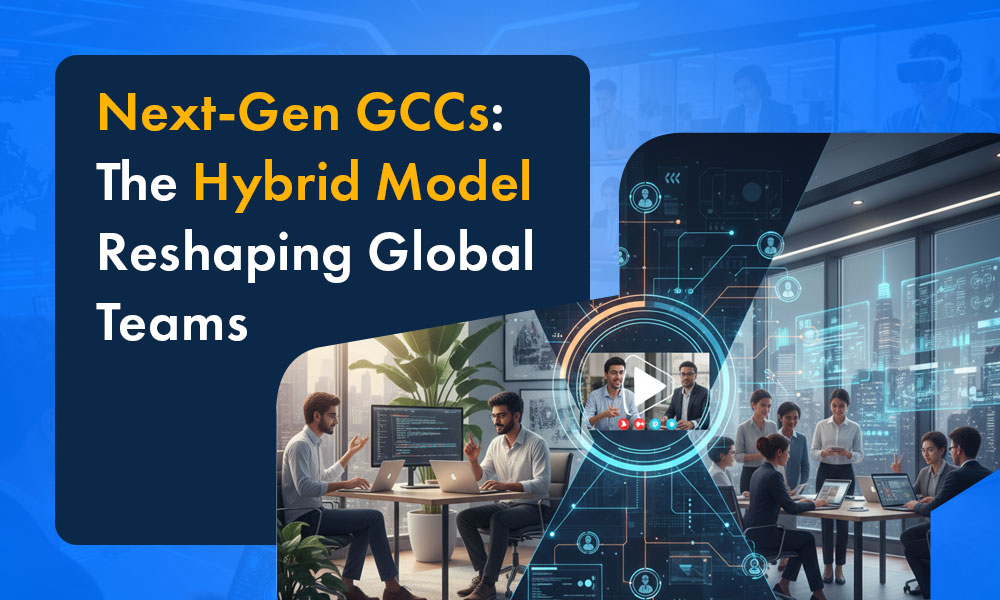One term that has firmly established itself as the torchbearer of a global transformative force is “Global Capability Center” or “GCC”. Industry chatter about this buzzword points fervently toward a business model that is at once profitable and revolutionary. GCCs have evolved from being mere back offices of American business behemoths situated in India to something more profound. Global brands are leveraging their GCC setups in India, the Philippines, Poland and other up-and-coming offshore and nearshore destinations to achieve major breakthroughs in technology, all while reducing costs to a great degree. And in 2025, GCCs are undergoing yet another evolution: the hybrid model.
Now, when we say hybrid, we’re not talking about hybrid cars or hybrid work (though that’s related)! We’re talking about a new global capability center operating model that blends the best of two polar opposite worlds: physical centers + remote teams. This approach is reshaping how businesses build, manage, and scale global teams.
But for the uninitiated, we’ll strive to understand what GCC stands for as the first milestone.
What Exactly is a GCC?
In the strictest sense, a GCC or global capability center is a wholly owned extension of a company’s core team, set up in a different geography, often in countries like India, Poland, the Philippines, or Mexico. You can think of it as a company within a company, delivering specialized services like product engineering, AI, data analytics, finance, cybersecurity, and customer experience.
As we’ve already discussed, over the last two decades, GCCs have shifted from transactional “back offices” to centers of excellence. Today, they co-own products, drive digital initiatives, and sometimes even set the innovation agenda for the parent enterprise. Microsoft, Google, Walmart, and Goldman Sachs have all invested big time in building these centers.
“India is a strategic hub for Accenture. Our GCCs in India are not just about cost savings; they are centers of innovation, driving our business forward.”
~ Julie Sweet, CEO, Accenture
The Traditional Brick and Mortar GCC
Swanky buildings, armies of employees walking in and out in shifts, the hum of computers and air conditioners, boardroom discussions—these are the images that come to mind when thinking about major global capability centers in India. And there’s a reason why it is so. GCCs in India and other countries have always been designed to emulate their larger partners like say, Google or Microsoft, in every possible way. And the yield has been staggering: 1700+ GCCs operating out of India alone, and employing around 2 million professionals! But, in the last couple of years, a roadblock has emerged, especially when it comes to scaling.
Brick and mortar offices, no matter how big and numerous, can only house so many people. After a point, the maintenance cost hits a seemingly unbreachable roof. And, a GCC, located in say a Tier 1 Indian city like Bengaluru, begins to feel a talent crunch. After a point, the only feasible solution seems to be remote work. Enter the hybrid model!
A Hybrid GCC Defined
A hybrid GCC is one that merges the traditional, brick-and-mortar GCC model with staff augmentation to create a workforce that’s distributed across geographies. But you need a closer look, don’t you?
1. The In-Office Core
The model still needs a backbone. That’s where the in-office teams come in. It handles leadership, governance, compliance-heavy tasks, and those collaboration-intensive projects where face-to-face problem-solving is a must-have. This central hub provides structure, accountability, and the cultural glue that keeps everything aligned with the parent enterprise, because alignment is crucial.
2. Remote Staffing Pods
Around this in-office core, Hybrid GCCs extend their reach through remote staffing. Engineers, data analysts, designers, and customer experience specialists no longer have to sit in one city and share office space. They can work from anywhere—Tier-2 hubs, small towns, a shack—imagine any place with a functioning internet and the necessary tools to execute a given task. This not only widens the talent funnel but also improves retention, since resources don’t have to uproot their lives to contribute to world-class projects.
3. Staff Augmentation as THE Savior
Business requirements change at supersonic speeds. And that’s where staff augmentation comes into play. Hybrid GCCs can quickly add specialized talent—say an AI engineer, a cybersecurity analyst, or a UX researcher—without investing in physical office space or waiting through drawn-out hiring cycles. It’s scalability without friction, like a tap that just needs to be opened and the best of the best resources come pouring.
4. Still a Wholly Owned Model
Here’s the crucial point: a Hybrid GCC is not outsourcing dressed up with a new name. It’s still a wholly owned global capability center, directly tied to the parent organization’s strategy and goals. The difference lies in the operating model. It embraces remote-first thinking to expand reach, improve flexibility, and optimize costs.
Why the Hybrid Model Works

At the heart of the Hybrid GCC lies a simple truth: talent is no longer tied to a single office or a single city. Remote staffing has changed the rules of the game. And that’s exactly why the hybrid model works so well.
1. Talent without borders:
With remote staffing, GCCs aren’t limited to hiring in Bengaluru, Manila, or Warsaw. They can tap into Tier-2 and Tier-3 cities, or even reach across continents. That means finding the right AI engineer in Kochi, a brilliant data scientist in Kraków, or a CX specialist in Cebu, all without forcing relocation.
2. Scale at speed with staff augmentation:
Markets shift fast, and businesses need to pivot at light speed. Hybrid GCCs can plug in additional talent through staff augmentation, scaling teams almost overnight. Instead of waiting for office build-outs or endless hiring cycles, companies can simply extend their distributed workforce.
3. Cost without compromise:
By blending in-office cores with remote resources, GCCs cut back on expensive office overheads while still maintaining leadership and compliance on-site. This isn’t just cost-cutting. It’s the art of freeing up budget for innovation in action.
4. Flexibility = retention:
Today’s workforce values flexibility more than fancy perks. Offering employees the option to work remotely, even part-time, boosts satisfaction and lowers attrition. Hybrid GCCs using remote staffing consistently report stronger retention compared to traditional office-only setups.
A Model That Knows No Failure
All this adds up to create a workforce that’s lean, efficient, and ready to pounce on growth opportunities by making mincemeat of complex projects. Think this way: remote staffing or staff augmentation is that enabler that allows a GCC to expand beyond borders and employ an army of exceptionally talented resources without stretching the budget even by the slightest bit.
That’s a win-win situation, if you ask us!



